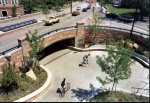Pedestrian countdown signals are beginning to appear more and more throughout our cities. Research shows that this type of signal helps to create a safer pedestrian experience.
The City of Toronto states on their website that
“The City of Toronto’s Transportation Services Division has installed ‘countdown’ signals at more than 2,100 intersections in the city to assist pedestrians in crossing the street.
“The devices provide a numeric count down display that indicates the number of seconds remaining for a pedestrian to complete their crossing of a street. The countdown counts the length of time between the current ‘walk’ signal and the solid ‘don’t walk’ signal which gives more precise information to the pedestrian than the current system.”
Pedestrian signals and pedestrian countdown signals were created with the intention of targeting pedestrians with information. But let me play devil’s advocate and ask – what if these signals are targeting drivers as well? Drivers are not the intended recipient of this information, but it has become common for drivers to use the countdown signal as a ‘pre-warning’ for the yellow light, helping them to make more informed decisions regarding their navigation and speed. Drivers may be doing this consciously or semi-consciously, but either way – drivers are not intended to be directly affected by the countdown signal.
 Devil’s advocate again here – what’s wrong with using this pre-warning for the intended pre-warning? Doesn’t the anticipation help the driver make more informed, and therefore safer decisions? This can hold some truth – for example, halting at a yellow light can be more dangerous than beginning to slow down naturally with a 10 second yellow light warning. But take a second and think about all of the times you’ve seen drivers abuse this information (similar to advance green arrows) – many drivers will use the countdown to make damn sure they get through the intersection no matter what. The second this happens, they are putting themselves first, and the second anyone on the road puts themselves first they are putting everyone else at risk (with shifts happening in modal split, awareness to ‘share the road’ is increasing, which means we must all be on the look out for each other, not simply ourselves).
Devil’s advocate again here – what’s wrong with using this pre-warning for the intended pre-warning? Doesn’t the anticipation help the driver make more informed, and therefore safer decisions? This can hold some truth – for example, halting at a yellow light can be more dangerous than beginning to slow down naturally with a 10 second yellow light warning. But take a second and think about all of the times you’ve seen drivers abuse this information (similar to advance green arrows) – many drivers will use the countdown to make damn sure they get through the intersection no matter what. The second this happens, they are putting themselves first, and the second anyone on the road puts themselves first they are putting everyone else at risk (with shifts happening in modal split, awareness to ‘share the road’ is increasing, which means we must all be on the look out for each other, not simply ourselves).
It has been brought to my attention that truck drivers and larger or heavier vehicles commonly take advantage of this signal and call it a ‘stale light’. This creates another grey area to be considered – does this mean that the roads travelled by trucks are not fit for larger or heavier vehicles? Does this mean that truckers need their own signal?
Aggressive driving is a risk factor, and my hypothesis is that this risk is increased when the pedestrian signal countdown targets the driver – the non-intended user. This raises the question – should the pedestrian signal have a different design, one that can target the intended user more successfully?
A Few Ideas…
ISOLATED PEDESTRIAN SIGNALS
A new design, or an addition to the current design, in order to attempt to block off the view to the existing signal light except for straight-on.
LINE-OF-VISION SIGNALS
Average ped height or low.
HIGHLIGHTED CROSSWALK
We’ve seen the futuristic renderings of all kinds of ‘highlighted’ crosswalks.
ACCESSIBLE PEDESTRIAN SIGNALS 2.0
Accessible Pedestrian Signals (APS) were designed to convey information through the auditory sense for the visually impaired. APS 2.0 could build on adding more ways to receive information by transferring the countdown onto a screen near where the button is positioned.

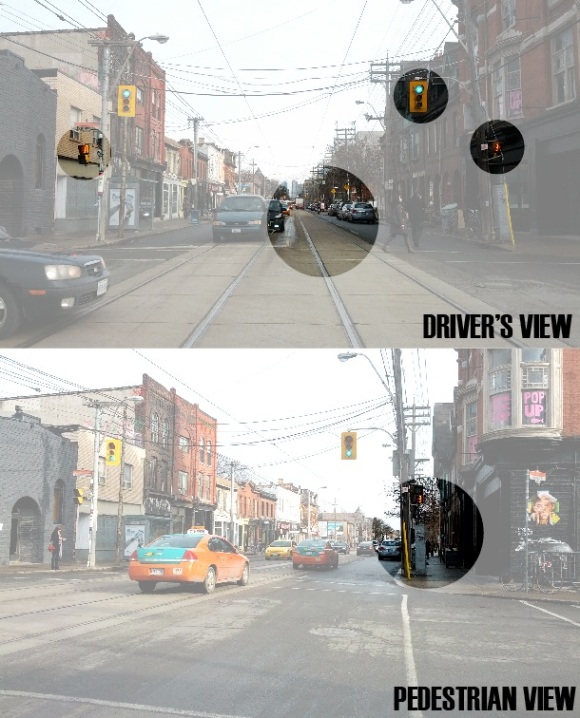


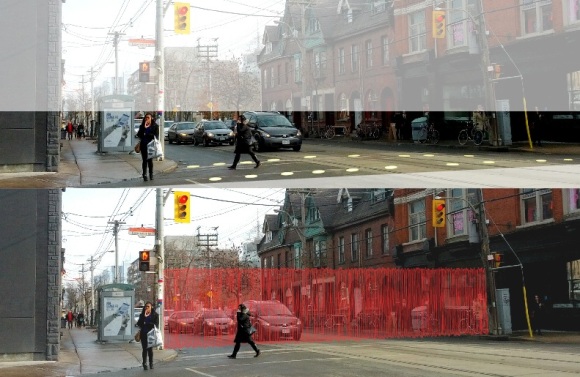

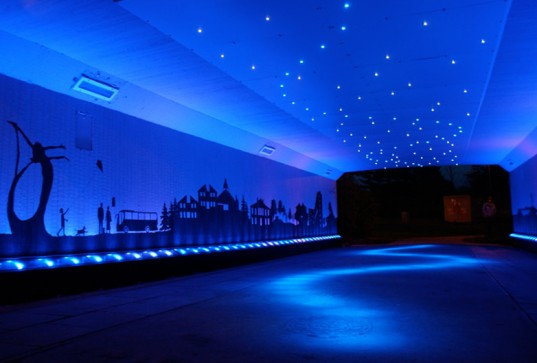


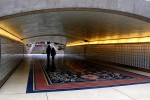
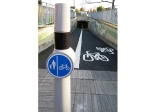

![full_melbourne-pedestrian-underpass[1]](https://mycityspot.files.wordpress.com/2013/02/full_melbourne-pedestrian-underpass1.jpg?w=150&h=100)

